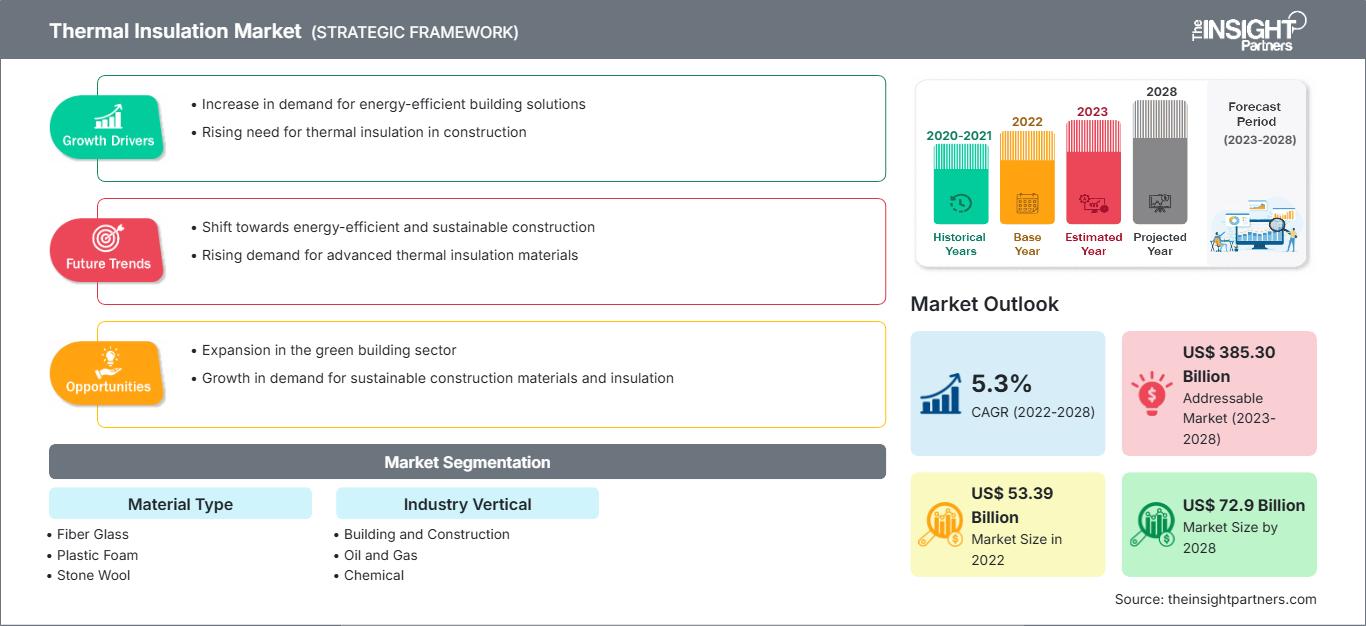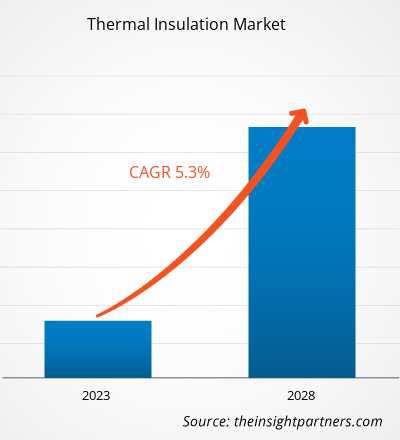预计隔热材料市场规模将从2022年的533.9亿美元增长到2028年的729亿美元;预计2022年至2028年的复合年增长率为5.3%。
隔热材料的需求因其诸多优势而增长。它能够降低能源成本,并减少两个不同温度物体之间的热传递。隔热材料能够反射、减少和吸收辐射热,从而起到隔热作用。各公司正专注于提供轻质产品,例如塑料,因为它易于安装,并且耗时省力。预计这些因素将促进隔热市场的增长。
由于巴斯夫 SE、拜耳股份公司、洛科威 A/S、Johns Manville、圣戈班 SA、金斯潘集团 PLC、陶氏化学公司、欧文斯科宁、旭化成株式会社和杜邦等知名企业的强劲存在,预计未来几年隔热市场将出现显著增长。各种各样的隔热产品引起了消费者的关注。人们越来越意识到高温隔热的好处,包括耐高温和热冲击、低导热性、环境效益和成本效益,这可能会推动隔热市场在预测期内的增长。
2021 年,亚太地区占据全球隔热市场的最大份额。然而,预计北美将在预测期内实现市场最高的复合年增长率。亚太市场细分为中国、印度、澳大利亚、日本、韩国和亚太其他地区。由于人口快速增长,建筑业是亚太地区蓬勃发展的行业之一;这最终导致了对隔热产品的需求旺盛。此外,消费者可支配收入水平的提高和中产阶级人口的增长也是推动该地区隔热市场增长的一些关键因素。
自定义此报告以满足您的要求
您将免费获得任何报告的定制,包括本报告的部分内容,或国家级分析、Excel 数据包,以及为初创企业和大学提供超值优惠和折扣
隔热市场: 战略洞察

-
获取本报告的主要市场趋势。这个免费样本将包括数据分析,从市场趋势到估计和预测。
新冠疫情对隔热材料市场的影响
新冠疫情爆发前,隔热材料市场的增长主要得益于建筑和施工活动需求的增长。然而,由于企业停工、原材料和劳动力短缺以及建筑和运输活动减少,市场在2020年第一季度面临重重障碍。新冠疫情导致2020年初几个月经济衰退,给低收入和中等收入消费者带来了财务困难。
此外,由于限制措施,许多建筑公司和制造业停工,影响了隔热材料市场的增长。此外,在疫情期间,劳动力短缺是隔热材料行业面临的一个主要问题。这导致了隔热行业向机械化、自动化和异地制造的转变。
市场洞察
使用隔热材料的好处
隔热材料可以减少热量移动和蒸汽凝结。因此,它可以防止建筑物中可能出现的潮湿、霉菌、冻结和变形,以及由于腐蚀导致的铁部件强度降低;并有助于建筑物的保护。此外,在各个行业中,通过使用BTU-BLOCK隔热材料等产品,可以降低内衬结构的导热系数,从而获得巨大的节能效益。
根据材料类型,全球市场分为玻璃纤维、塑料泡沫、岩棉、硅酸钙、泡沫玻璃等。2021年,玻璃纤维部分占据了最大的收入份额,而塑料泡沫预计将在预测期内占据最高的增长率。按行业垂直划分,全球市场细分为建筑施工、石油天然气、化工、航空航天和国防、汽车、制药等。建筑施工领域占据了最大的收入份额。
巴斯夫集团、拜耳集团、洛科威集团、Johns Manville、圣戈班集团、金斯潘集团、陶氏化学公司、欧文斯科宁、旭化成株式会社和杜邦是隔热材料市场中的几家主要参与者。这些公司为市场提供了广泛的产品组合。这些公司在发展中地区都有业务,提供了丰厚的市场机会。市场参与者正在开发高质量的创新产品,以满足客户要求。
报告重点
- 市场中不断发展的行业趋势,帮助参与者制定有效的长期战略
- 发达市场和发展中市场采用的业务增长战略
- 2022 年至 2028 年隔热产品市场规模的定量分析
- 全球隔热需求估算
- PEST 分析,说明行业买家和供应商的效率
- 了解竞争激烈的市场形势的最新发展
- 市场趋势和前景以及推动和抑制隔热市场增长的因素
- 通过强调支撑商业利益的市场战略来协助决策过程,从而促进市场增长
- 不同节点的隔热市场规模
- 市场以及隔热行业的详细概述和细分动态
- 各地区隔热市场规模及增长潜力
隔热市场区域洞察
The Insight Partners 的分析师已详尽阐述了预测期内影响隔热材料市场的区域趋势和因素。本节还讨论了北美、欧洲、亚太地区、中东和非洲以及南美和中美洲的隔热材料市场细分和地域分布。
隔热市场报告范围
| 报告属性 | 细节 |
|---|---|
| 市场规模 2022 | US$ 53.39 Billion |
| 市场规模 2028 | US$ 72.9 Billion |
| 全球复合年增长率 (2022 - 2028) | 5.3% |
| 历史数据 | 2020-2021 |
| 预测期 | 2023-2028 |
| 涵盖的领域 |
By 材料类型
|
| 覆盖地区和国家 |
北美
|
| 市场领导者和主要公司简介 |
|
隔热市场参与者密度:了解其对业务动态的影响
隔热材料市场正在快速增长,这得益于终端用户需求的不断增长,而这些需求的驱动因素包括消费者偏好的不断变化、技术进步以及对产品优势的认知度不断提高。随着需求的增长,企业正在扩展产品线,不断创新以满足消费者需求,并抓住新兴趋势,从而进一步推动市场增长。

- 获取 隔热市场 主要参与者概述
《2028年隔热市场分析》是一项针对消费品行业的专业而深入的研究,特别关注全球隔热市场趋势分析。该报告旨在提供市场概览和详细的市场细分。
隔热市场按材料类型、行业垂直领域和地域细分。根据材料类型,全球市场细分为玻璃纤维、塑料泡沫、岩棉、硅酸钙、泡沫玻璃等。根据行业垂直领域,全球市场细分为建筑、石油和天然气、化工、航空航天和国防、汽车、制药等。按地域划分,市场大致分为北美、欧洲、亚太地区 (APAC)、中东和非洲 (MEA) 以及南非和加勒比地区。中美洲。
公司简介
巴斯夫公司 (BASF SE)、拜耳公司 (Bayer AG)、洛科威公司 (ROCKWOOL A/S)、Johns Manville、圣戈班公司 (SAINT GOBAIN SA)、金斯潘集团 (Kingspan Group PLC)、陶氏化学公司 (Dow Chemicals Company)、欧文斯科宁公司 (Owens Corning)、旭化成公司 (Asahi Kasei Corporation) 和杜邦公司 (DuPont) 是全球隔热材料市场的主要参与者。
- 历史分析(2 年)、基准年、预测(7 年)及复合年增长率
- PEST和SWOT分析
- 市场规模、价值/数量 - 全球、区域、国家
- 行业和竞争格局
- Excel 数据集
近期报告
相关报告
客户评价
购买理由
- 明智的决策
- 了解市场动态
- 竞争分析
- 客户洞察
- 市场预测
- 风险规避
- 战略规划
- 投资论证
- 识别新兴市场
- 优化营销策略
- 提升运营效率
- 顺应监管趋势






















 获取免费样品 - 隔热市场
获取免费样品 - 隔热市场